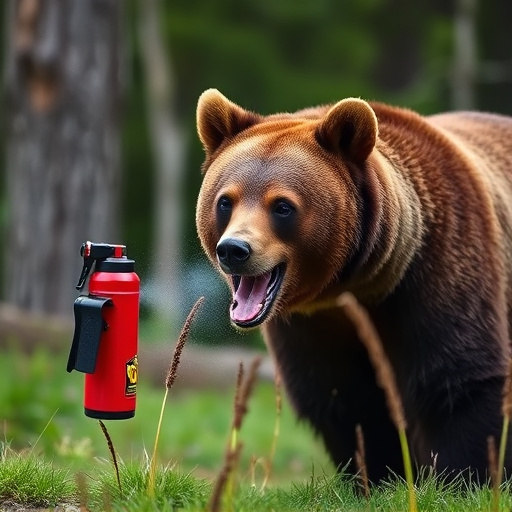Bear spray effectiveness depends on capsaicin percentage (AI%), ranging from 2% to 7%. Higher AI% (10%+ recommended) increases deterrence but check local regulations. Aim for face and eyes from a distance, practice usage, keep within arm's reach for optimal protection against black bears.
In areas inhabited by black bears, knowing how to defend yourself is crucial. One of the most popular tools for bear protection is bear spray—a potent deterrent that can stop an attack in its tracks. Understanding the effectiveness of bear spray, its key active ingredients (often with specific percentage concentrations), and proper usage techniques is essential for safety in the great outdoors. This guide covers everything from selecting the right spray strength to vital safety precautions, empowering you to navigate bear country confidently.
- Understanding Bear Spray Effectiveness
- Key Active Ingredients in Bear Deterrents
- How to Choose the Right Spray Strength
- Application Techniques for Optimal Protection
- Safety Precautions When Using Bear Spray
Understanding Bear Spray Effectiveness
Bear spray, also known as pepper spray specifically designed for bear encounters, has become a popular defense mechanism for hikers and outdoor enthusiasts navigating bear country. Its effectiveness lies in its active ingredient—a powerful capsaicin compound similar to that found in chili peppers. The concentration of this active ingredient varies, with typical bear spray cans containing between 10% and 34% capsaicin by volume.
This percentage is crucial as it directly impacts the spray’s impact. Higher concentrations offer more protection, ensuring a longer-lasting and stronger response against aggressive bears. Understanding the bear spray active ingredient percentage empowers users to make informed decisions when choosing their defense option. It’s not just about availability but also about matching the right concentration to the specific challenges of the environment one plans to navigate.
Key Active Ingredients in Bear Deterrents
Bear deterrents, especially bear spray, are designed to protect individuals from potential attacks by black bears. The key active ingredient in most bear sprays is capsaicin, derived from chili peppers. This compound irritates the bear’s eyes, nose, and throat, causing them to retreat. Typically, bear spray contains capsaicin at a concentration of 10% or higher for maximum effectiveness.
Other active ingredients may include various oils and chemicals that enhance the spray’s performance. For instance, some brands incorporate oils like canola or peanut oil to increase visibility and stickiness, ensuring the capsaicin coats the bear’s fur and mucous membranes. Additionally, surfactants are added to help the spray adhere to surfaces, prolonging its duration and reach. These combinations make bear deterrents a powerful tool for outdoor enthusiasts navigating bear country.
How to Choose the Right Spray Strength
When selecting bear spray, one of the crucial factors is choosing the right strength, measured by the active ingredient percentage (AI%). Higher AI% typically means more potent spray, offering increased protection against aggressive bears. The standard range for effective black bear defense is between 2% and 4% capsaicin, the active ingredient derived from chili peppers. This concentration provides a balance between effectiveness and safety, ensuring the spray irritates the bear enough to deter an attack without causing severe harm.
Opting for a stronger spray with an AI% above 4% is recommended for those frequently venturing into areas known for aggressive bear behavior or during certain times of year when bears are more active and protective of their cubs. However, always check local regulations regarding bear spray strength, as recommendations can vary based on region and specific bear species.
Application Techniques for Optimal Protection
To ensure optimal protection against black bears, proper application techniques are crucial. It’s essential to understand that bear spray is most effective when used correctly. Aim for the bear’s face and eyes, as this area contains high-concentration nerve endings. The ideal distance to deploy the spray is between 20 to 30 feet (6 to 9 meters), allowing for maximum coverage without blowing the spray back towards you.
Remember, not all bear spray products are created equal. Look for a brand that contains at least 15% of the active ingredient capsaicin, which is known to be highly effective in deterring bears. The concentration ensures a strong enough spray to create a barrier between you and the bear, providing crucial seconds to escape or regroup.
Safety Precautions When Using Bear Spray
When using bear spray, safety precautions are paramount. Always ensure you have a clear understanding of the product’s instructions and warnings before heading into bear country. Bear spray is designed to create a barrier between you and the bear by temporarily blinding and disorienting it, giving you time to escape. However, it’s crucial to remember that bear spray is not a foolproof solution; its effectiveness depends on factors like distance, wind direction, and the bear’s behavior.
To maximize the spray’s potential, know your bear spray’s active ingredient percentage—typically between 2% and 7%. This concentration plays a significant role in how well it will perform during an encounter. Additionally, keep bear spray readily accessible, preferably within arm’s reach, and practice using it regularly to build confidence and ensure you can deploy it quickly in an actual emergency.
Bear spray is a valuable tool for personal safety in bear country, but its effectiveness depends on understanding key components and proper usage. By knowing the active ingredient percentage and choosing the right spray strength, along with learning application techniques and safety precautions, individuals can enhance their protection against black bears. Always remember that responsible wilderness behavior and knowledge of local guidelines are equally important when venturing into bear habitat.
